Create vibrant soap colors using natural vegetable dyes like turmeric for yellow-orange, carrot powder for orange, spinach juice for green, beet root for pink, and red cabbage for purple-pink hues. You'll get rich browns from coffee grounds, deep reds from madder root, blues from indigo, and blackish tones from activated charcoal. For custom shades, try combining dyes like turmeric with madder root. These plant-based colorants offer endless possibilities for your handcrafted soaps.
Essential Equipment and Safety Measures for Vegetable Dyeing
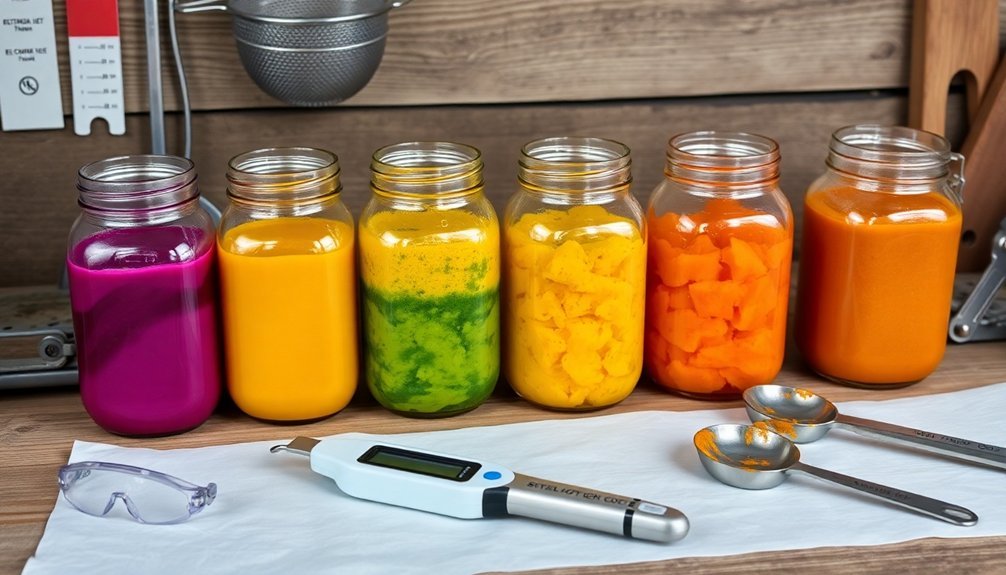
When working with vegetable dyes for soap-making, you'll need specific equipment and safety measures to guarantee successful results.
Your essential equipment should include stainless steel or glass pots for boiling, strainers for filtering, and storage containers for your dye solutions. These materials prevent unwanted chemical reactions that could affect your natural ingredients.
For safety measures, you'll want to wear protective gloves and an apron to shield your skin and clothes from stains. Always work in a well-ventilated space to avoid inhaling fumes from boiling plant materials.
Before applying dye to your final soap project, test it on a small fabric sample to check the color outcome. Remember to monitor pH levels, as they can impact the final shade, and properly dispose of wastewater according to local guidelines.
Understanding Color Extraction Methods From Plants
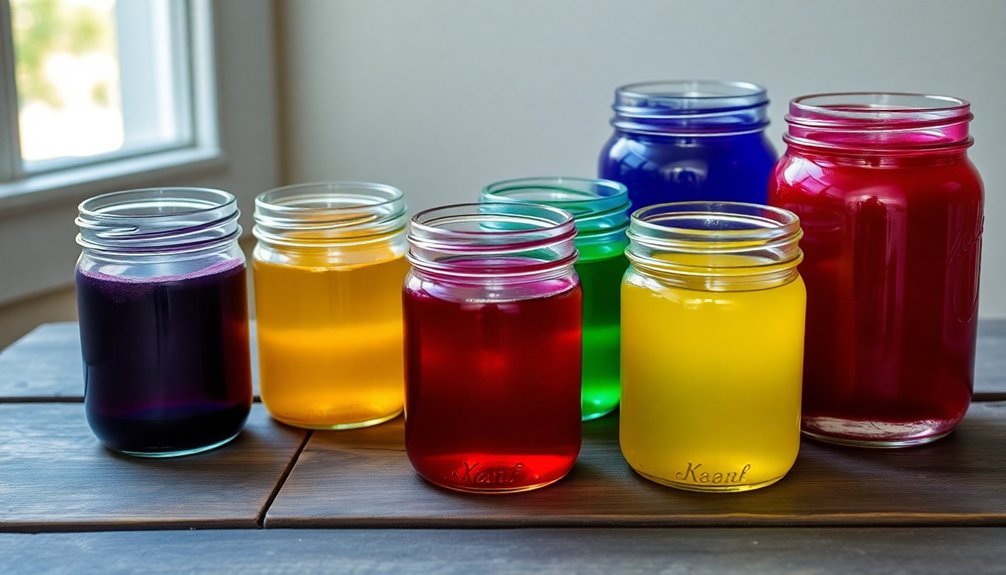
While extracting vibrant colors from plants may seem challenging, mastering a few fundamental methods will help you achieve consistent results in your soap-making journey.
You'll find that color extraction techniques vary based on your chosen plant material and desired outcome.
For soap making, you'll want to focus on creating infused oils, as they provide the best color vibrancy. Start by selecting either fresh or dried plant material, though dried options often work better to prevent spoilage.
Using infused oils from dried plants yields the most vibrant natural colors while ensuring your soap remains free from spoilage.
The key to successful natural dye extraction lies in maintaining proper ratios – you'll need enough plant material in relation to your oil base to achieve your target shade.
Begin with small test batches to perfect your technique. You can extract colors through boiling, soaking, or infusing, but remember that each method affects the final hue differently.
Carrot and Pumpkin: Creating Orange Hues
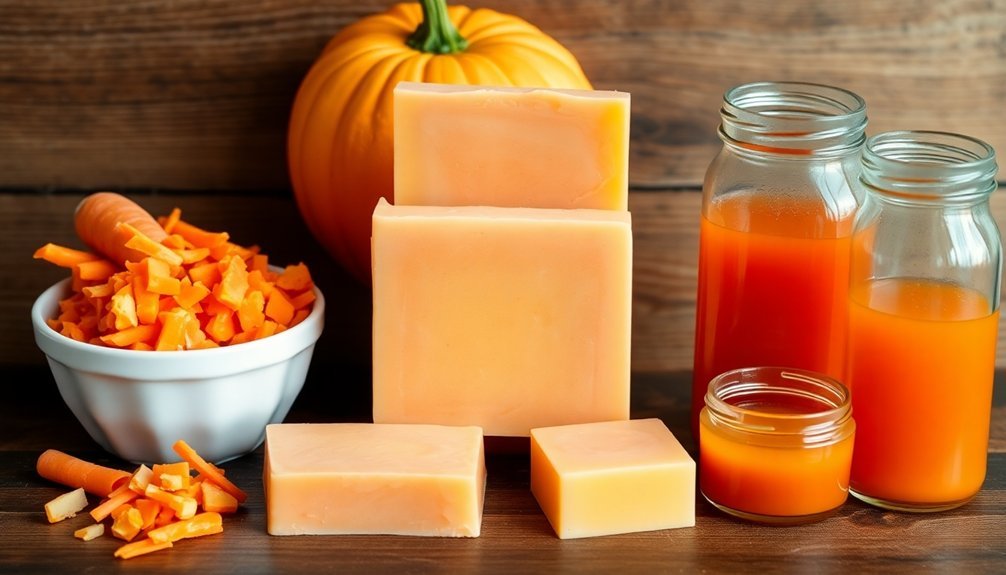
Natural orange hues create some of the most appealing colors in handmade soap, and both carrots and pumpkins offer excellent options for achieving these warm tones. You'll find that carrot powder and pumpkin puree work particularly well as natural colorants, especially in cold-process soap where they produce vibrant results.
| Ingredient | Benefits | Best Practice |
|---|---|---|
| Carrot Powder | Beta-carotene rich | Blend with oils first |
| Pumpkin Puree | Moisturizing | Test small batches |
| Both Options | Natural color | Monitor light exposure |
For the best results, you'll want to blend your chosen colorant with your soap oils before combining with other ingredients. Remember that these natural colorants may change over time, so it's wise to test small batches first to understand how your orange hues will develop and maintain their vibrancy.
Spinach and Nettle: Achieving Natural Greens
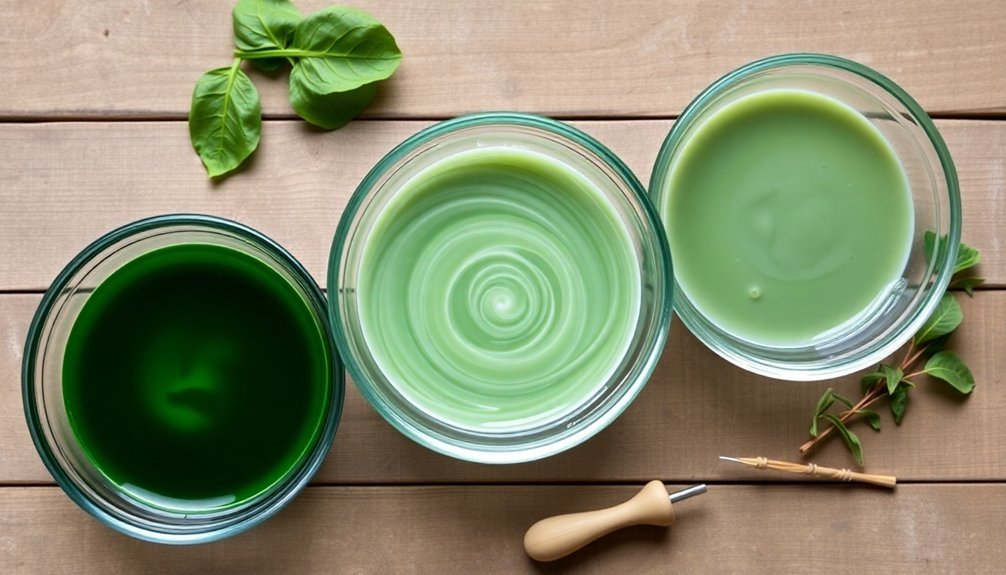
For crafters seeking earth-friendly green dyes, spinach and nettle offer excellent alternatives to synthetic colorants in soap making.
You'll find that fresh spinach juice integrates better than spinach powder, creating vibrant green natural soap colors that blend seamlessly into your mixture.
If you're making shampoo bars, nettle powder can be particularly effective.
To maximize its potential, try infusing dried nettle in your soap-making oils first – this technique often yields more intense green hues.
When working with either plant material, it's smart to start with small test batches to see how the colors develop during saponification.
Remember that both spinach and nettle-based colors can fade with light exposure, so you'll want to store your finished soaps properly to maintain their natural vibrancy as long as possible.
Beet Root and Red Cabbage: Exploring Pink Shades
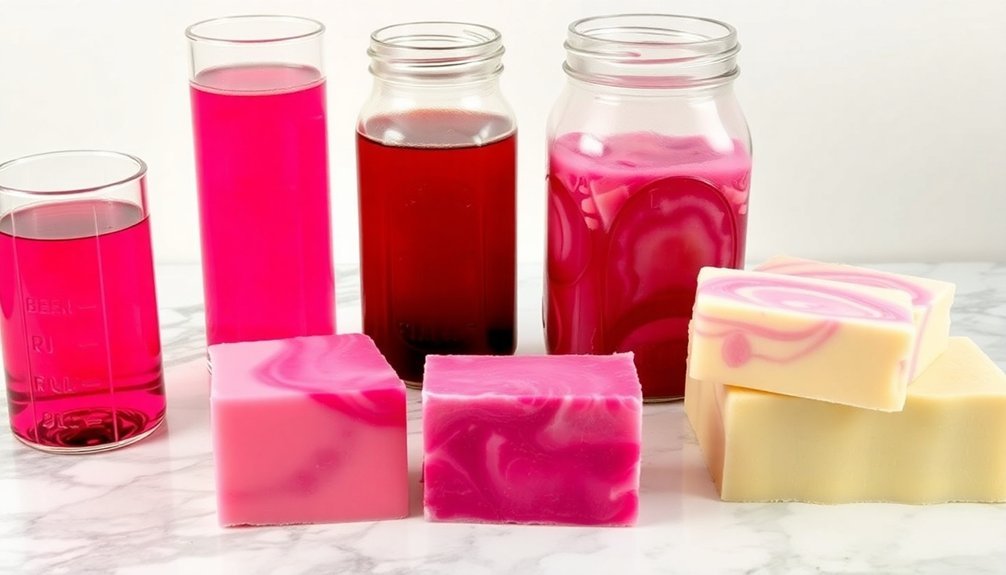
When you're creating pink soap with beet root or red cabbage, you'll need to infuse these vegetables into oils or mix their powders with lye solution to extract their vibrant colors.
You can control the final shade by adjusting your soap's pH level – red cabbage produces pink in acidic conditions while beet root works best at concentrations up to 5% of total soap weight.
To maintain the longevity of your naturally-dyed soaps, you'll want to store them in a cool, dark place since these plant-based colors can fade with exposure to light and air.
Natural Color Extraction Methods
Creating pink shades for your homemade soap starts with two readily available plant sources: beet root and red cabbage.
These natural color extraction methods require careful preparation to achieve vibrant, lasting results. You'll find that beet root powder works best through cold infusion with oils or water, while red cabbage needs boiling to release its colorful compounds.
Here's how to maximize your color extraction:
- Use dried beet root powder instead of fresh juice for more concentrated pigments.
- Prepare red cabbage through boiling, adjusting pH levels to control the final shade.
- Test small batches first to perfect your desired pink hue.
- Store finished soaps away from direct sunlight to prevent colors from starting to fade over time.
Remember that both colorants will gradually lose intensity, but proper storage helps maintain their beauty longer.
Soap Ph Color Effects
The pH level of your soap directly influences how beet root and red cabbage express their colors during the saponification process. You'll notice that these natural colorants respond differently to your soap's alkalinity, creating unique color variations in your final product.
| pH Level | Beet Root | Red Cabbage |
|---|---|---|
| Very Acidic | Bright Pink | Vivid Pink |
| Mildly Acidic | Light Pink | Rose Pink |
| Neutral | Pale Pink | Purple |
| Mildly Alkaline | Faded Pink | Blue-Purple |
| Very Alkaline | Light Peach | Deep Blue |
When you're working with beet root, you'll achieve the most vibrant pinks in slightly acidic conditions. Red cabbage acts as a natural pH indicator, shifting from pink to blue as your soap becomes more alkaline. While beet root's color may fade over time, red cabbage provides a reliable visual gauge of your soap's pH balance.
Storage and Stability Tips
Now that you understand how pH affects your natural colorants, proper storage becomes the next key to success.
Both beet root powder and red cabbage dyes require specific storage conditions to maintain their vibrant pink hues. You'll need to protect these natural colorants from light and air exposure to maximize their color stability.
To preserve your natural soap dyes effectively:
- Store all dye materials in airtight containers to prevent oxidation.
- Keep your storage area cool and dark to minimize color degradation.
- Add a splash of vinegar to red cabbage dye before use to help lock in color.
- Test small batches first to gauge how your storage methods affect color retention.
Turmeric and Saffron: Yellow Color Sources
To achieve a lasting yellow color in your homemade soap, you'll find turmeric offers reliable results when used at up to 5% of total soap weight, while saffron provides a more premium golden hue.
You can enhance the vibrancy of both colorants by infusing them in your soap-making oils before beginning the process.
Both natural dyes maintain their stability in high pH environments, though you should keep in mind that turmeric may gradually fade with prolonged light exposure.
Proper Usage Ratios
Creating vibrant yellow soap requires careful attention to ratios when using natural colorants like turmeric and saffron.
For turmeric soap, you'll want to use no more than 5% of your total soap weight to achieve that perfect golden hue.
While saffron's potent coloring power means you'll need even less, it's crucial to prepare both ingredients properly before adding them to your mixture.
- Mix turmeric with your soap oils before blending to maximize color distribution
- Keep turmeric usage at 5% or less of total soap weight
- Infuse saffron in warm oil for several hours before adding to soap
- Start with small test batches to gauge color intensity and fading
Both colorants can change over time, so it's worth documenting your results and adjusting your ratios accordingly for future batches.
Natural Soap Color Stability
Understanding the stability of natural yellow colorants can make or break your soap-making success. When working with natural soap colorants like turmeric and saffron, you'll need to take into account their unique stability characteristics in your formulations.
| Property | Turmeric | Saffron |
|---|---|---|
| Color Stability | Good in cold process | Variable |
| Light Sensitivity | May fade over time | More resistant |
| pH Tolerance | Changes in high pH | Stable in most pH |
| Usage Rate | Up to 5% | Up to 5% |
| Cost-effectiveness | Economical | Premium-priced |
For ideal natural soap color stability, you'll want to test small batches first. While turmeric provides a reliable yellow shade in cold-process soaps, it might fade with light exposure. Saffron offers more predictable results when properly sourced, though at a higher cost. Remember that both colorants perform best when used within the recommended 5% maximum concentration.
Oil Infusion Methods
While oil infusions serve as a reliable method for incorporating natural yellow colorants into soap, turmeric and saffron stand out as top choices for their distinct properties.
These oil infusion methods allow you to create rich, stable colors that'll enhance your soap's appearance naturally.
To achieve the most vibrant final product with either colorant, follow these essential steps:
- Mix your chosen amount of turmeric powder or saffron strands with a carrier oil, using a higher ratio for deeper color.
- Heat the mixture gently for several hours, allowing the pigments to release fully.
- Monitor the temperature carefully to avoid overheating the infusion.
- Strain the mixture thoroughly before adding it to your soap base.
Combining Plant Dyes for Custom Colors
To expand your natural soap-coloring palette, you'll discover endless possibilities by combining different plant-based dyes. You'll achieve vibrant oranges and pinks by blending turmeric with madder root, while mixing alkanet root with annatto seeds creates stunning mauve and lavender shades. For deeper colors, try infusing oils with multiple plant materials like spirulina and chlorella for rich greens.
| Base Color | Complementary Dye | Custom Result |
|---|---|---|
| Turmeric | Madder Root | Orange-Pink |
| Alkanet | Annatto | Mauve |
| Charcoal | Beet Powder | Black-Red |
Keep detailed records of your combinations and ratios to replicate successful custom colors in future batches. You'll find that experimenting with different proportions of natural soap making ingredients leads to unique, personalized shades that set your creations apart.
Preserving Color Intensity in Cold Process Soap
Before committing to a large batch of colored soap, you'll want to make small test batches with your chosen vegetable dyes to understand how they behave during saponification.
For the most vibrant results, infuse your plant materials into oils before incorporating them into your soap mixture, keeping the total colorant amount at 5% or less of your soap's weight.
You can maintain your soap's beautiful hues by storing the finished bars away from direct sunlight, as natural plant dyes tend to fade with prolonged light exposure.
Test Small Batches First
Since natural vegetable dyes can behave unpredictably in cold process soap, testing small batches is essential for preserving color intensity.
By experimenting with limited quantities, you'll understand how your natural colorants interact with lye and develop during saponification. Remember to keep your colorants at 5% or less of your total soap weight for ideal results.
- Document your test results carefully, noting any color changes or fading that occurs during the curing process.
- Connect with other soap making enthusiasts to learn from their experiences with specific vegetable dyes.
- Observe how different natural colorants behave before scaling up to larger batches.
- Test multiple color combinations to discover which ones create the most vibrant colors in your finished soap.
This methodical approach will help you achieve consistent, beautiful results in your naturally-colored soaps.
Oil Infusion Best Practices
Building on your test batch results, you'll want to maximize color intensity through proper oil infusion techniques. Start by combining dried plant materials with your chosen oils at a ratio of 1:2 by weight.
For ideal oil infusion best practices, allow the mixture to infuse for several weeks, helping the oils absorb vibrant hues from the plant materials.
You can accelerate the process by applying gentle heat during infusion, but don't overheat, as this can degrade the color compounds.
Once your infused oils reach the desired intensity, strain them through cheesecloth to remove any remaining plant particles. This guarantees a smooth, consistent colorant for your soap making.
Remember to document your infusion times and results, as different plant materials may require varying durations to achieve your desired color strength.
Proper Storage Prevents Fading
Once you've created beautifully colored soaps using natural dyes, proper storage becomes essential for maintaining their vibrancy.
Selecting the right storage conditions will prevent fading and help your natural colorants retain their beautiful hues longer. Keep your handcrafted soaps in a cool, dark environment away from direct sunlight and heat sources that can diminish their appearance.
- Store soaps in airtight containers or wrap them securely to protect against moisture and air exposure.
- Choose a cool, dark storage space to maintain vibrant colors and prevent premature fading.
- Use stable natural colorants like clays and mineral pigments for longer-lasting results.
- Monitor your stored soaps regularly and aim to use them within a year.
Remember that even with proper storage, natural dyes may gradually change over time, so it's best to enjoy your soaps while they're at their peak appearance.
Testing and Recording Your Dye Results
Testing your vegetable dyes systematically guarantees reliable and repeatable results for future soap batches.
When you're testing new natural dyes, always start with small batches to evaluate the color outcome before scaling up your production. You'll want to record specific details about your process, including the ratios of vegetable material to soap base and your extraction method.
Document both the initial color in your raw soap mixture and how it changes during saponification, as many natural dyes can shift dramatically during this process.
Keep detailed notes about your dye type, extraction technique, and any additives that might affect color stability.
Don't forget to monitor your soaps over time, making observations about how the colors hold up under different lighting conditions and noting any fading that occurs.
Storage and Shelf Life of Vegetable-Dyed Soaps
After documenting your dye results, proper storage becomes the next key factor in maintaining your vegetable-dyed soaps' quality and appearance.
You'll want to maximize the shelf life of your natural soaps by storing them correctly, as they're more sensitive to environmental factors than synthetic alternatives.
Keep your soaps in prime condition with these essential storage practices:
- Store your soaps in a cool, dark location to prevent color fading from light exposure.
- Use airtight containers to protect against oxidation and rancidity.
- Monitor your soaps regularly for signs of mold or deterioration.
- Label containers with creation dates, as most vegetable-dyed soaps last 6-12 months.
Remember that different vegetable dyes have varying stability levels, so you'll need to pay extra attention to soaps made with less stable colorants.
Frequently Asked Questions
How Do You Make Vibrant Colors in Soap?
You'll get vibrant soap colors by infusing natural dyes like turmeric, beetroot, and spirulina into oils before mixing with lye. Keep colorants at 5% of total soap weight and test combinations for unique shades.
What Herbs Are Good for Coloring Soap?
You'll get vibrant yellows from turmeric, pinks from madder root, and purples from alkanet root. Try spirulina or matcha for greens, and annatto seeds for orange. Just watch out for chlorella causing DOS.
Is It Safe to Put Food Coloring in Soap?
You shouldn't use food coloring in soap – it can irritate your skin and won't provide reliable results. Instead, try natural alternatives like herbs, clays, or plant-based colorants for safer, more consistent soap making.
How to Make Colourful Soap?
You can create colorful soap by adding natural dyes like beetroot for pink, turmeric for yellow, or spirulina for green. Remember to infuse oils with these ingredients and test small batches first.
In Summary
With these natural vegetable dyes, you'll create vibrant, eco-friendly soaps while avoiding synthetic colorants. Remember to document your experiments, noting which combinations work best for your soap recipes. Keep testing different plant materials and extraction methods to expand your color palette. While vegetable-dyed soaps may fade faster than those with artificial colors, they'll give you unique, naturally beautiful results that your customers will love.

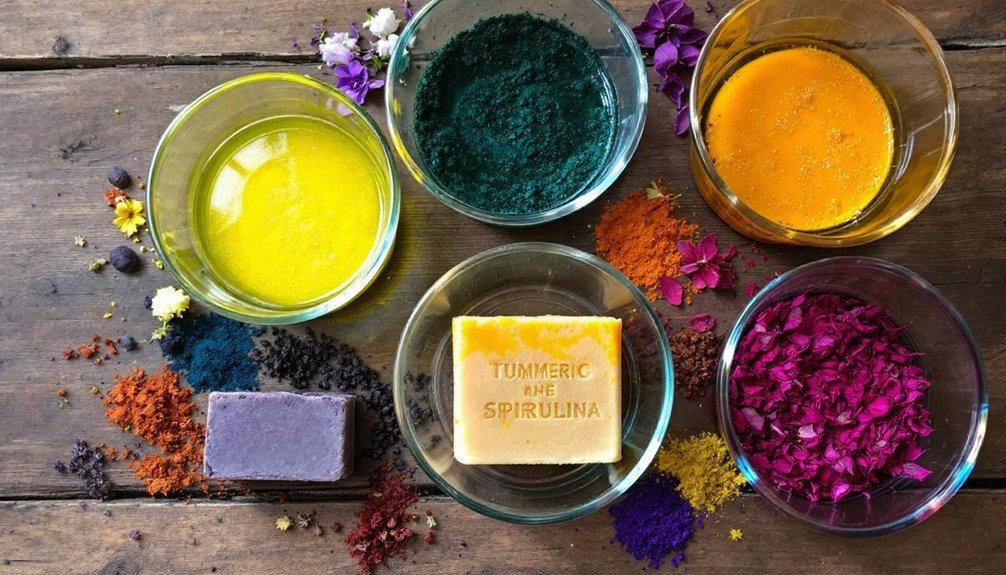



Leave a Reply